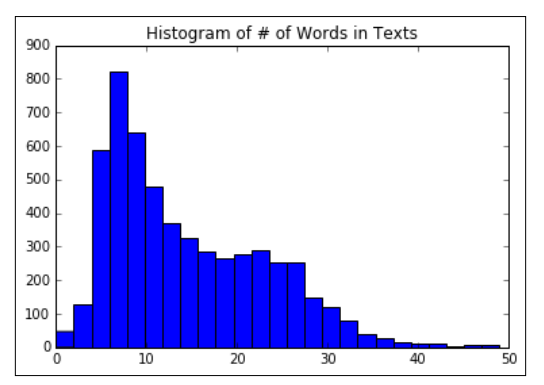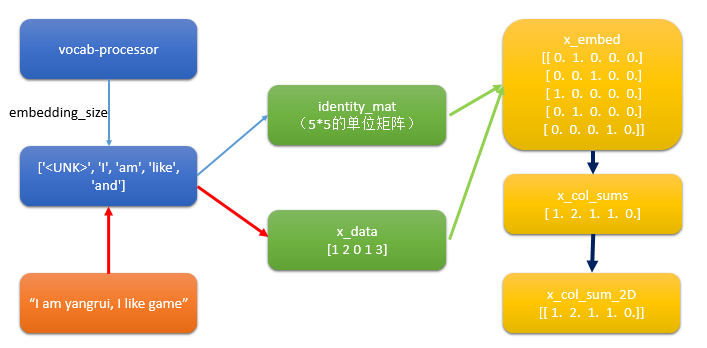tensorflow在文本处理中的使用——词袋
代码来源于:tensorflow机器学习实战指南(曾益强 译,2017年9月)——第七章:自然语言处理
代码地址:https://github.com/nfmcclure/tensorflow-cookbook
解决问题:使用“词袋”嵌入来进行垃圾短信的预测(使用逻辑回归算法)
缺点:不考虑相关单词顺序特征,长文本的处理困难
步骤如下:
step1:导入需要的包
step2:准备数据集
step3:选择参数(每个文本保留多少单词数,最低词频是多少)
step4:构建词袋
step5:分割数据集
step6:构建图
step7:训练
step8:测试
step1:导入需要的包
import tensorflow as tf
import matplotlib.pyplot as plt
import os
import numpy as np
import csv
import string
import requests
import io
from zipfile import ZipFile
from tensorflow.contrib import learn
from tensorflow.python.framework import ops
ops.reset_default_graph() # Start a graph session
sess = tf.Session()
step2:准备数据集
# Check if data was downloaded, otherwise download it and save for future use
save_file_name = os.path.join('temp','temp_spam_data.csv')
if os.path.isfile(save_file_name):
text_data = []
with open(save_file_name, 'r') as temp_output_file:
reader = csv.reader(temp_output_file)
for row in reader:
text_data.append(row)
else:
zip_url = 'http://archive.ics.uci.edu/ml/machine-learning-databases/00228/smsspamcollection.zip'
r = requests.get(zip_url)
z = ZipFile(io.BytesIO(r.content))
file = z.read('SMSSpamCollection')
# Format Data
text_data = file.decode()
text_data = text_data.encode('ascii',errors='ignore')
text_data = text_data.decode().split('\n')
text_data = [x.split('\t') for x in text_data if len(x)>=1] # And write to csv
with open(save_file_name, 'w') as temp_output_file:
writer = csv.writer(temp_output_file)
writer.writerows(text_data) texts = [x[1] for x in text_data]
target = [x[0] for x in text_data] # Relabel 'spam' as 1, 'ham' as 0
target = [1 if x=='spam' else 0 for x in target] # Normalize text,为减少无意义的词汇,对文本进行规则化处理
# Lower case
texts = [x.lower() for x in texts] # Remove punctuation
texts = [''.join(c for c in x if c not in string.punctuation) for x in texts] # Remove numbers
texts = [''.join(c for c in x if c not in '') for x in texts] # Trim extra whitespace
texts = [' '.join(x.split()) for x in texts]
step3:选择参数
# Plot histogram of text lengths文本数据中的单词数的直方图
text_lengths = [len(x.split()) for x in texts]
text_lengths = [x for x in text_lengths if x < 50]
plt.hist(text_lengths, bins=25)
plt.title('Histogram of # of Words in Texts')

step4:构建词袋
# Choose max text word length at 25,也可以设为30或者40
sentence_size = 25
min_word_freq = 3 # Setup vocabulary processor
vocab_processor = learn.preprocessing.VocabularyProcessor(sentence_size, min_frequency=min_word_freq) # Have to fit transform to get length of unique words.
vocab_processor.fit_transform(texts)
embedding_size = len(vocab_processor.vocabulary_)
step5:分割数据集
# Split up data set into train/test
train_indices = np.random.choice(len(texts), round(len(texts)*0.8), replace=False)
test_indices = np.array(list(set(range(len(texts))) - set(train_indices)))
texts_train = [x for ix, x in enumerate(texts) if ix in train_indices]
texts_test = [x for ix, x in enumerate(texts) if ix in test_indices]
target_train = [x for ix, x in enumerate(target) if ix in train_indices]
target_test = [x for ix, x in enumerate(target) if ix in test_indices]
step6:构建图
step6.1:构建出文本的向量
# Setup Index Matrix for one-hot-encoding,使用该矩阵为每个单词查找稀疏向量
identity_mat = tf.diag(tf.ones(shape=[embedding_size])) # Create variables for logistic regression
A = tf.Variable(tf.random_normal(shape=[embedding_size,1]))
b = tf.Variable(tf.random_normal(shape=[1,1])) # Initialize placeholders
x_data = tf.placeholder(shape=[sentence_size], dtype=tf.int32)
y_target = tf.placeholder(shape=[1, 1], dtype=tf.float32) # Text-Vocab Embedding,使用tf的嵌入查找函数来映射句子中的单词为单位矩阵的one-hot向量,再进行求和
# tf.nn.embedding_lookup(y,x)x为索引,找出y中对应索引的值
x_embed = tf.nn.embedding_lookup(identity_mat, x_data)
x_col_sums = tf.reduce_sum(x_embed, 0) # Declare model operations
x_col_sums_2D = tf.expand_dims(x_col_sums, 0)
疑问:如何利用词袋将文本变成向量?

step6.2 构建图
model_output = tf.add(tf.matmul(x_col_sums_2D, A), b) # Declare loss function (Cross Entropy loss)
loss = tf.reduce_mean(tf.nn.sigmoid_cross_entropy_with_logits(model_output, y_target)) # Prediction operation
prediction = tf.sigmoid(model_output) # Declare optimizer
my_opt = tf.train.GradientDescentOptimizer(0.001)
train_step = my_opt.minimize(loss)
step7:训练
# Intitialize Variables
init = tf.initialize_all_variables()
sess.run(init) # Start Logistic Regression
print('Starting Training Over {} Sentences.'.format(len(texts_train)))
loss_vec = []
train_acc_all = []
train_acc_avg = []
for ix, t in enumerate(vocab_processor.fit_transform(texts_train)):
y_data = [[target_train[ix]]] sess.run(train_step, feed_dict={x_data: t, y_target: y_data})
temp_loss = sess.run(loss, feed_dict={x_data: t, y_target: y_data})
loss_vec.append(temp_loss) if (ix+1)%10==0:
print('Training Observation #' + str(ix+1) + ': Loss = ' + str(temp_loss)) # Keep trailing average of past 50 observations accuracy
# Get prediction of single observation
[[temp_pred]] = sess.run(prediction, feed_dict={x_data:t, y_target:y_data})
# Get True/False if prediction is accurate
train_acc_temp = target_train[ix]==np.round(temp_pred)
train_acc_all.append(train_acc_temp)
if len(train_acc_all) >= 50:
train_acc_avg.append(np.mean(train_acc_all[-50:]))
step8:测试
# Get test set accuracy
print('Getting Test Set Accuracy For {} Sentences.'.format(len(texts_test)))
test_acc_all = []
for ix, t in enumerate(vocab_processor.fit_transform(texts_test)):
y_data = [[target_test[ix]]] if (ix+1)%50==0:
print('Test Observation #' + str(ix+1)) # Keep trailing average of past 50 observations accuracy
# Get prediction of single observation
[[temp_pred]] = sess.run(prediction, feed_dict={x_data:t, y_target:y_data})
# Get True/False if prediction is accurate
test_acc_temp = target_test[ix]==np.round(temp_pred)
test_acc_all.append(test_acc_temp) print('\nOverall Test Accuracy: {}'.format(np.mean(test_acc_all))) # Plot training accuracy over time
plt.plot(range(len(train_acc_avg)), train_acc_avg, 'k-', label='Train Accuracy')
plt.title('Avg Training Acc Over Past 50 Generations')
plt.xlabel('Generation')
plt.ylabel('Training Accuracy')
plt.show()
tensorflow在文本处理中的使用——词袋的更多相关文章
- tensorflow在文本处理中的使用——TF-IDF算法
代码来源于:tensorflow机器学习实战指南(曾益强 译,2017年9月)——第七章:自然语言处理 代码地址:https://github.com/nfmcclure/tensorflow-coo ...
- tensorflow在文本处理中的使用——CBOW词嵌入模型
代码来源于:tensorflow机器学习实战指南(曾益强 译,2017年9月)——第七章:自然语言处理 代码地址:https://github.com/nfmcclure/tensorflow-coo ...
- tensorflow在文本处理中的使用——Doc2Vec情感分析
代码来源于:tensorflow机器学习实战指南(曾益强 译,2017年9月)——第七章:自然语言处理 代码地址:https://github.com/nfmcclure/tensorflow-coo ...
- tensorflow在文本处理中的使用——skip-gram模型
代码来源于:tensorflow机器学习实战指南(曾益强 译,2017年9月)——第七章:自然语言处理 代码地址:https://github.com/nfmcclure/tensorflow-coo ...
- tensorflow在文本处理中的使用——Word2Vec预测
代码来源于:tensorflow机器学习实战指南(曾益强 译,2017年9月)——第七章:自然语言处理 代码地址:https://github.com/nfmcclure/tensorflow-coo ...
- tensorflow在文本处理中的使用——skip-gram & CBOW原理总结
摘自:http://www.cnblogs.com/pinard/p/7160330.html 先看下列三篇,再理解此篇会更容易些(个人意见) skip-gram,CBOW,Word2Vec 词向量基 ...
- tensorflow在文本处理中的使用——辅助函数
代码来源于:tensorflow机器学习实战指南(曾益强 译,2017年9月)——第七章:自然语言处理 代码地址:https://github.com/nfmcclure/tensorflow-coo ...
- (数据科学学习手札71)在Python中制作个性化词云图
本文对应脚本及数据已上传至我的Github仓库https://github.com/CNFeffery/DataScienceStudyNotes 一.简介 词云图是文本挖掘中用来表征词频的数据可视化 ...
- TensorFlow实现文本情感分析详解
http://c.biancheng.net/view/1938.html 前面我们介绍了如何将卷积网络应用于图像.本节将把相似的想法应用于文本. 文本和图像有什么共同之处?乍一看很少.但是,如果将句 ...
随机推荐
- python ddt 实现数据驱动
ddt 是第三方模块,需安装, pip install ddt DDT包含类的装饰器ddt和两个方法装饰器data(直接输入测试数据) 通常情况下,data中的数据按照一个参数传递给测试用例,如果da ...
- 2018-11-21-WPF-解决-ViewBox--不显示线的问题
title author date CreateTime categories WPF 解决 ViewBox 不显示线的问题 lindexi 2018-11-21 09:37:53 +0800 201 ...
- 集合--Map&&HasMap和TreeMap
特点:以键值对key,value方式存储的结构 key:Set集合 key能重复,无序的,如果重复,后面的key会把前面的覆盖掉(key必须是唯一的,不唯一,那么后面的value会把前面的va ...
- MacOS配置双网
目的 日常工作中,我们可能会同时需要用到公司的内网以及互联网,为了避免来回的切换,我们可以通过配置电脑的两个网卡来实现同时访问内网和互联网. 环境说明 互联网 无线网卡 网关 子网掩码 内网 有线网卡 ...
- php7 新内容
1.use增强 以thinkphp5.0为例 namespace app\home\controller;use think\{Loader,Controller,Captcha,Request}; ...
- jq 操作CSS
方式有两种,一种是操作元素className间接控制样式,一种是设置css属性值直接控制样式. jQuery 属性操作方法.jQuery CSS 操作函数 1.addClass() $(selecto ...
- 洛谷1758 BZOJ1566 管道取珠题解
题目链接 一道人类智慧的dp题 首先我们可以将∑ai^2转化为求取两次,两次一样的方案数 然后用f[i][j][k][l]表示第一个人在第一个串中取到i第二个串中取到j 第二个人在一个串中取到k第二个 ...
- BZOJ 3884 上帝与集合的正确用法题解
一道智慧题 其实解这题需要用到扩展欧拉定理, 有了上面的公式,我们不难看出此题的解法. 设b为2^2^2^2^2.....显然,b要比φ(p)要大,所以可以直接套公式 modp时的答案 ans(p)= ...
- shell学习(15)- eval及shell No such file or directory解决办法
eval可以读取一连串的参数,然后按照参数特性来执行.参数数目不限,彼此之间用分号隔开. eval会对后面的命令进行两遍扫描,如果第一遍扫描后,命令是个普通命令,则执行此命令:如果命令中含有变量的间接 ...
- axios细节之绑定到原型和axios的defaults的配置属性
把axios绑定到原型 vue开发者一套很好用的实践,一般来说,实践如果能够让大部分人都接受,会逐渐成为一个默认的标准. // 把axios配置到原型上 Vue.prototype.$axios = ...
